Survey Results
This chapter provides a discussion of the findings from the survey in relation to:
- the profile of recreational SBT anglers active in 2012;
- the expenditure associated with recreational SBT fishing in 2012;
- the willingness to pay over and above the 2012 expenditure of recreational SBT fishing; and
- the profile of charter boat operators active in the 2012 SBT season.
A full summary of the responses to the survey of recreational SBT anglers, including a comparison of results between anglers on charter boats and anglers on private boats, is provided in Appendix D. A summary of responses to the survey of charter boat operators is provided in Appendix F.
3.1 Profile of recreational SBT anglers
The SBT fishing season in Portland attracts a substantial group of recreational anglers with accompanying visitors travelling an average one-way distance of 300km.
The importance of the SBT fishing season in Portland for recreational fishing is clear: of 497 anglers surveyed, 385 (77%) targeted SBT exclusively, while the remainder targeted SBT along with other species. Among the respondents, only 26 (5%) of the anglers were from Portland, while 95% of the anglers travelled to Portland – in the vast majority of cases for the sole purpose of fishing (93.8%).
For visitors to Portland the distance travelled ranged from 17km to 1,612km, with 307km being the average distance travelled, which is only a little less than the distance between Melbourne CBD and Portland (see the distribution of distance travelled in Chart 3.1). A map with the location of anglers' places of residence is provided in Figure 3.1.
Chart 3.1: Travel distance from place of residence
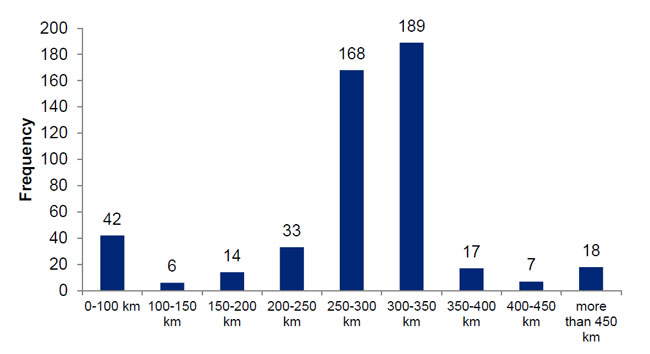
Figure 3.1: Distance travelled from place of residence
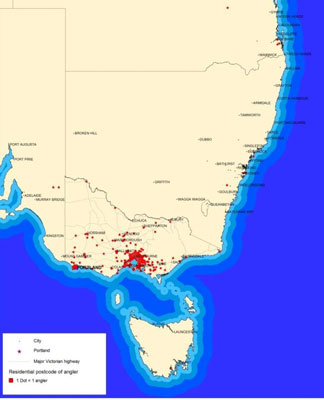
Source: Deloitte Access Economics
Anglers typically drove to Portland – either in their own car (54.3%) or in someone else's car (39.4%), as shown in Chart 3.2. This often involved bringing a boat on a trailer, as 66.4% of the anglers surveyed used a private boat12, while the remainder fished from one of the many charter boats operating from Portland.
The majority of anglers travelled to Portland with other people, with 96% of anglers in Portland accompanied on their trip by an average of 3.1 people (i.e. 4 people per journey altogether). On the day of the survey, 94% of the anglers went on a boat with other anglers (2.8 on average), resulting in an average group of 3.8 anglers on a boat trip per fishing day.13
Chart 3.2: Mode of travel to the SBT fishery in Portland
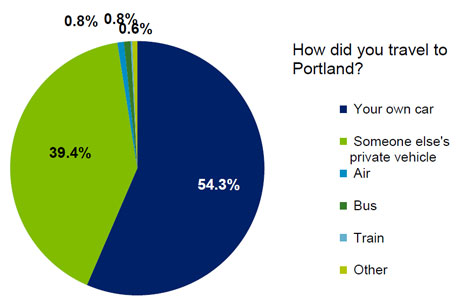
Anglers spend about 30% of their annual fishing effort (days) in the SBT season in Portland.
In terms of the stay, 97.6% of the anglers spent between one to five fishing days on their current visit to Portland (2.1 days on average), with the average fishing day involving 6.5 hours of fishing. Anglers expressed planning to visit the SBT fishery in Portland for a total of 6.1 days in 2012, while spending 15.6 days in other fishing locations in 2012. Thus, for the anglers surveyed the proportion of fishing days spent in the SBT fish season in Portland accounts for a substantial share (about 30%) of total annual fishing days.
Half of current anglers would stop travelling to Portland if there were less or no SBT fish.
In terms of anglers' preferences towards Portland as the location to access the SBT fishery, 23.7% would stop coming to Portland if there were less SBT fish, and 44.3% would not be in Portland if there were no SBT fish. The joint responses show that 50.5% would stop coming to Portland in either case (i.e. with less or no SBT). A small share (5.2%) of anglers expressed counterintuitive answers, in which they would go to Portland if there were no SBT, but would not if there were less SBT.
Most of the respondents are frequent anglers combining catch-to-keep and catch-and-release fishing practices.
In terms of fishing practice, most anglers (81.7%) practiced both 'catch and release' and 'catch and keep' fishing. Only 2.2% of anglers expressed a preference for 'catch and release' exclusively, while 16.1% had a preference for 'catch and keep'. On the day of the survey, anglers caught or expected to catch (if interviewed prior their fishing trip14) an average of 3.0 SBT (of which 1.4 were kept and 1.6 were released) and 1.5 other fish (of which 1.3 were kept and only 0.2 were released). A small number of anglers reported retained catches greater than the bag limit. These are most likely reporting errors where the catch for the whole boat, not the individual fisher, were recorded (see Chart 3.3 for details).
Chart 3.3: Relative catch of SBT (non-zero catch and release versus catch to keep)
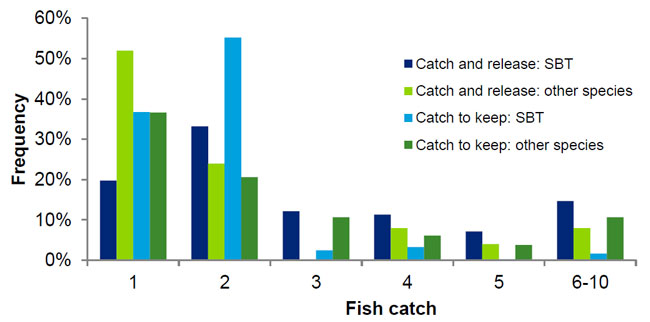
The majority of respondents appear to be regular or frequent anglers, as 53.5% held a three-yearly licence and 32.0% held an annual licence. 8.2% anglers did not need any fishing licence. The remainder used a weekly, daily or other type of licence. Only 12.7% anglers bought their recreational fishing licence in Portland, from this group 20.6% paid for the licence on the day of the survey, which is only 2.6% of the full sample. Only a small proportion (19.7%) of the anglers are affiliated with recreational fishing clubs or associations.
3.2 Expenditure: observed total travel costs
Anglers on charter boats and anglers on private boats were split into two groups for the analysis of average expenditure per angler, mainly due to the differences in the structure of the fishing-related expenses.
The mean expenditure per angler fishing day (which represents one angler spending one day fishing in Portland) was estimated at $381.0815, consisting of the following spend categories according to the type of angler in the SBT season in Portland:
- Annual fixed costs were converted into daily expenditure using the total number of days anglers are planning to fish in 2012 (21.7 days on average), while variable costs were calculated based on the number of fishing days in the current visit to Portland.
- Variable costs were broadly classified according to their purpose, i.e. associated with either travel/holiday or fishing. Most average travel costs (including fuel) were shared among members of a group travelling together, while fishing related costs were generally borne by the individual anglers surveyed. Fees for charter boats were summarised separately.
The breakdown of expenditure per day and angler for anglers on charter boats and anglers on private boats is presented in Table 3.1.
| Anglers on charter boats | Anglers on private boats | Full sample | |
|---|---|---|---|
| Fixed costs | - | $21.35 | $14.17 |
| Charter boat fees | $263.49 | - | $88.54 |
| Fishing related expenditure | $15.85 | $114.81 | $81.56 |
| Travel related expenditure | $228.86 | $180.60 | $196.81 |
| TOTAL EXPENDITURE | $508.19 | $316.75 | $381.08 |
The total expenditure per angler fishing trip in the SBT season amounts to $317 for anglers on private boats and $508 for anglers on charter boats, as summarised in Table 3.2 (for consistency, anglers on charter boats were assumed not to have fixed annual costs in the analysis16). Detailed expenditure on individual items is provided in Appendix E.
Anglers spend on average $381 per fishing day, which is the value placed per angler, as a minimum, to enjoy the recreational experience of SBT fishing in Portland.
Chart 3.4 shows the substantial proportion of charter fees (about 50% of total costs), reflecting the fact that service providers incur most of the fishing-related costs, such as boat fuel, safety equipment, bait, tackle, etc. In the case of anglers on private boats, fixed and variable fishing related costs combined account for 43% of total costs. Altogether, fishing related expenditure was significantly higher for anglers on charter boats ($279.34) than for anglers on private boats ($136.16).
Chart 3.4: Total travel costs per angler fishing day
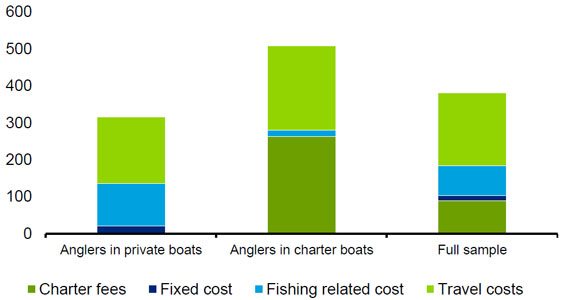
Some anglers reported large expenditure on fixed annual items17, particularly in relation to boat ownership, likely reflecting purchases of assets undertaken in a given year rather than the annual costs from such purchases. Instead of treating these cases as outliers, we used a straight line depreciation function to calculate the annual component of such transactions corresponding to the stay in Portland. This consideration applied to boat purchase values greater than $10,000, assuming an average of 8 years replacement period, based on preliminary estimates in the Ernst & Young (2009) study for recreational fishing in Victoria.
Sensitivity checks
The expenditure defined under the TCM involves a number of travel cost definitions, which typically focus on transport costs. In the present analysis, transport costs are based on fuel expenditure reported by anglers. As a double check on these self-reported costs, fuel costs are recalculated based on the travel distance and running costs of $0.25 per km, as a robustness check, giving slightly higher travel costs estimates as compared to those presented previously.
In addition, most TCM studies do not account for accommodation, food or drinks expenditure, as it is not totally clear that the costs for either of these items are directly related to the recreational fishing experience. For instance, accommodation may encompass personal preferences for comfort in relation to overnight stays, while expenditure in food and drinks is not necessarily additional, i.e. the same or even higher levels of expenditure on food and drinks may be incurred if the group had not travelled anyway. The estimates of the total travel costs under these variants are presented in the table below.
| Sensitivity case | Private boats | Charter boats | Full sample |
|---|---|---|---|
| Total costs (Fuel costs calculated from travel distance) | $326.15 | $524.01 | $393.54 |
| Travel costs not including accommodation, food or drinks | $163.59 | $308.42 | $212.26 |
3.3 Willingness to pay measures
Half of the anglers would be willing to pay for a one-off right to secure the recreational experience in the SBT fishery.
Of the anglers surveyed, 223 (44.9%) said that they would be willing to pay for a one-off right to secure the recreational fishing experience that is currently available in the SBT fishery. Of this group, 57% said that they would be willing to pay up to $50 and 27% said that they would be willing to pay between $50 and $100 for such a right. The distribution for the willingness to pay to secure the fishery is shown in Chart 3.5 below.
Chart 3.5: Willingness to pay for a one-off right to secure the SBT fishery in Portland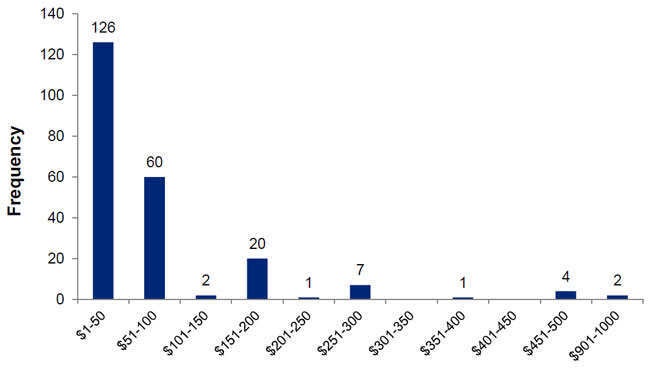
Most anglers would be willing to pay an additional 10% on their current travel costs to continue accessing the SBT fishery. About half of the anglers would be willing to pay for an additional 20% and one-fifth would be willing to pay an additional 50%.
If the travel costs associated with the visit to Portland for recreational fishing were to increase by a given percentage of angler's actual expenses:
- 85.3% of surveyed anglers would be willing to pay 10% above their current expenditure (amounting to $30 per day for anglers on a charter boat and $14 per day for anglers on a private boat);
- 52.5% of anglers would be willing to pay 20% above their current expenditure (amounting to $60 per day for anglers on a charter boat and $28 per day for anglers on a private boat); and
- 18.3% of anglers would be willing to pay 50% above their current expenditure (amounting to $151 per day for anglers on a charter boat and $70 per day for anglers on a private boat).
The value of the maximum additional expenditure expressed by anglers through these questions is summarised in Chart 3.6.
Chart 3.6: Willingness to pay on additional travel costs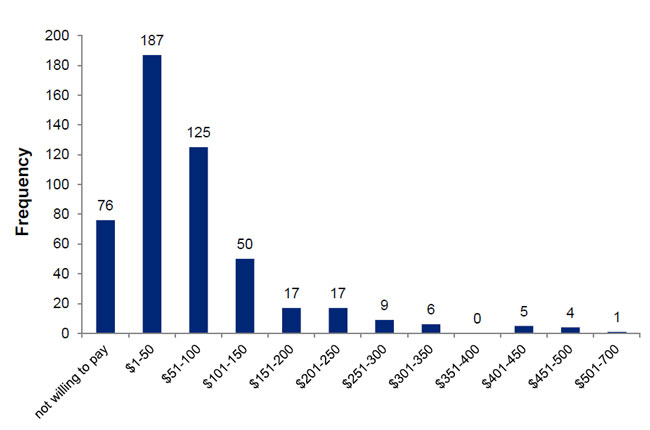
82.4% anglers would be willing to travel further if there were no SBT in Portland.
In terms of whether anglers would be willing to travel further if there were no SBT inPortland and instead had to be caught off a different port, 82.4% stated that they would bewilling to travel further – 774km on average. In the full sample, the average distanceanglers would be willing to travel further was 636km, while the median was 400km (seeChart 3.7). Anglers that were willing to travel international or extremely long distanceswere treated as outliers and are not included in our statistics.
Chart 3.7: Willingness to travel further for SBT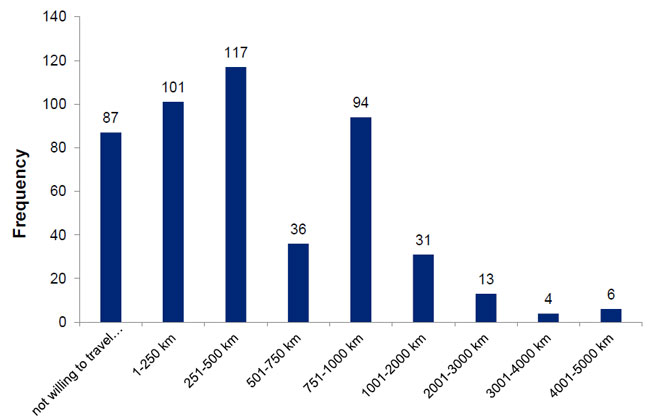
Although some anglers would realistically be willing to travel overseas and pay for a recreational fishing experience for a particular species, including this handful of observations introduces a problem: the travel-related costs can only be calculated on the basis of road trips and would therefore not be comparable to the spend reported by most anglers. Thus, our current estimates do not take into account the value placed by international residents on to access the SBT fishery.
The total observed expenditure associated with the 2012 SBT season in Portland is on average $381 per angler fishing day. However, total willingness to pay, consisting of the travel cost expenditure and additional stated willingness to pay, adds to a total value per angler fishing day of about $ 454. This represents the average valuation of the experience per angler fishing day, of which $73 represents surplus value.
3.4 Charter boat operators
To gain a better understanding of the recreational fishing industry, 20 representatives from 18 charter boat operators were interviewed, which comprises all charter boat operators active in Portland in the 2012 SBT season. In what follows, we compare the estimates on the numbers of customers and days operating over the SBT season, along with charter boat operators' expenditure, obtained from the responses provided to our survey, with the estimates from statistics reported previously by DPI (2012) on the 2011 SBT season.
Charter boat operators estimate an average of 55.6 days in the 2012 SBT season (with one charter operator anticipating a maximum of 130 days)18. This compares with an average of 55.2 days for the 2011 SBT season. The change in activity was mainly due to two new charter operator firms becoming active in 2012, as compared to 2011, but the number of days per week they operate generally remains constant: charter boat operators operated around 3.6 days per week in the 2012 SBT season and 3.5 days in 2011.
On average, charter boat operators had 5.9 customers per charter boat trip (on the survey day, there were 5.4 customers on a boat). Combined with the anticipated days of operation, this would amount to an average of 323 customers per charter boat operator in the 2012 SBT season – from an average of 318.5 customers per charter boat operator in the 2011 SBT season. Overall, the charter boat operators surveyed expected to have 6,460 customers in 2012, slightly up from 6,370 customers in 2011.
In terms of their annual expenditure associated with SBT fishing, charter boat operators spent on average $11,736 on a boat and $3,163 on other items in Portland. More detail on individual expenditure categories (as an input into the economic contribution analysis undertaken by DEPI) are provided in Appendix F. Charter boat operators' revenue is given by charter boat fees, which were around $253 (i.e. between $180 and $325) for a full day fishing trip of 7.8 hours in length.
3.5 Limitations of the survey estimates and sensitivity testing
Estimates are surrounded by some degree of uncertainty due to the inherently uncertain nature of sample survey data. A sample should provide a good representation of true estimates of key variables of a population of interest. In practice, a sample is unlikely to attain the true value across a set of variables of the full population and a raft of (often unknown) factors may affect results. This survey of recreational SBT anglers was designed in a way to ensure that the sample is as representative as possible and potential bias is limited, as discussed in Section 2.4. However, there were no data of the underlying population of recreation anglers going to Portland, and their preferences, that would have been able to inform every aspect of our survey design.
Hence, the results provided in this study are the best available estimates of expenditure and participation to date based on survey responses. However, a number of limitations to the sampling design and its practical implementation may remain and affect our survey findings. Sensitivity analysis was undertaken to quantify the impact of those potential risks and uncertainties where possible. However, for some of the risks and uncertainties discussed in this section this was not possible, due to lack of data.
Some of the most significant uncertainties and issues that may have affected the estimate of the value of the recreational SBT fishery are outlined below. They include:
- timing of the surveys;
- weather;
- overrepresentation of local anglers and anglers on charter boats; and
- other exogenous factors.
Timing of the surveys
In order to maximise representativeness of the sample, sampling days should be randomised as much as possible. However, practical and budget reasons limited this, as explained in Chapter 2. The approach chosen (four blocks of five days spread over five weeks) was to ensure that the sample was as random as possible within the constraints of project timing and budget.
It is possible that the timing of the surveys had an impact on the average expenditure, e.g. if anglers who visited the fishery early in the season valued the fishery more than visitors that came later in the season. It is impossible to know whether and if so to which extent the current valuation of the recreational SBT fishery under- or overestimates the true value of the fishery. Comparing average expenditure across the four survey blocks (Table 3.3) however, suggests that while expenditure varies, there does not appear to be a systematic bias in the sample selection.
|
Block 1 2-6 May 2012 (n = 90) Block 2 |
12-16 May 2012 (n = 121) |
Block 3 25-29 May 2012 (n = 124) |
Block 4 7-11 June 2012 (n = 162) | Total Sample (n = 497) | |
|---|---|---|---|---|---|
| Average expenditure per angler fishing day ($) | $436.29 | $354.98 | $432.50 | $330.04 | $381.08 |
| Standard deviation | $288.86 | $211.68 | $343.74 | $267.97 | $284.14 |
| Standard error | ±30.45 | ±19.24 | ±30.87 | ±21.05 | ±12.75 |
Weather
Some anglers plan to go fishing in advance and their decision to come to Portland may not be very responsive to weather (or its forecast). However, there may also be some anglers that are responsive to changes in weather (this may be, particularly, the case for anglers based locally and using private boats) and there is a risk that bad weather could filter out some participants to the survey.
Deloitte Access Economics has analysed the weather data for Portland available from the Bureau of Meteorology (BOM) and found that both the rainfall and wind speed19 observed over the sampling period in Portland were representative of the weather patterns of the entire season in 2012. Similarly, the sea heights observed over the survey were in line with the sea height SBT season data for 2012, which were provided by DEPI from a weather forecasting model similar to the BOM model. A comparison of main weather variables over the SBT season and survey blocks is provided in the tables below.
|
Average rainfall [mm] |
St.Dev [mm] | Count of days with more than 1mm | Average rainfall above 1mm | |
|---|---|---|---|---|
| March 2012 | 2.47 | 4.80 | 8 | 8.5 |
| April 2012 | 1.33 | 2.44 | 10 | 3.8 |
| May 2012 | 3.39 | 4.36 | 20 | 5.1 |
| June 2012 | 5.75 | 9.34 | 16 | 10.6 |
| Total over the SBT 2012 Season | 3.24 | 5.24 | 54 | 7.0 |
| Survey days | 3.26 | 4.92 | 12 | 5.3 |
|
Average wind speed [km/h] |
St.Dev [km/h] | Count of days with more than 20km/h | Average wind speed above 20km/h | |
|---|---|---|---|---|
| March 2012 | 19.6 | 9.02 | 15 | 29.3 |
| April 2012 | 17.2 | 7.04 | 10 | 26.9 |
| May 2012 | 17.7 | 7.45 | 13 | 27.1 |
| June 2012 | 17.7 | 7.66 | 15 | 25.8 |
| Total over the SBT 2012 Season | 18.0 | 7.79 | 53 | 27.3 |
| Survey days | 14.2 | 4.72 | 4 | 21.50 |
| Note: the average wind speed is based on two daily measurements taken at 9am and 3pm | ||||
|
Average sea height [m] |
St.Dev [m] | Count of days above 5m | Average sea height above 5m | |
|---|---|---|---|---|
| March 2012 | 3.28 | 1.29 | 4 | 7.2 |
| April 2012 | 3.74 | 1.42 | 12 | 5.8 |
| May 2012 | 3.80 | 1.13 | 9 | 5.8 |
| June 2012 | 3.87 | 1.11 | 10 | 5.6 |
| Total over the SBT 2012 Season | 3.68 | 1.24 | 35 | 6.1 |
| Survey days | 3.52 | 0.83 | 1 | 5.3 |
| Note: the average sea height is based on two daily measurements taken at 9am and 3pm | ||||
The relative participation of anglers on private and charter boats is expected to fluctuate over the course of the season. This fact combined with the effects of weather (amongst other influencing factors) needs to be considered in the analysis of survey results. Table 3.7 shows participation and average expenditure per angler fishing day on good and bad weather days. The table shows that the sample obtained presents a balanced participation of anglers over good and bad weather days. It may also suggest that anglers spending more towards recreational fishing are less likely to change their plans because of the weather. Overall, we found a higher participation in good weather days, as expected, but the difference in expenditure across respondents on good and bad weather days does not appear to be statistically significant. Thus, there is no evidence of issues arising from the variation in weather over the sampling period.
|
9 good weather days (n = 286) |
11 bad weather days (n= 211) |
Total Sample (n = 497) | |
|---|---|---|---|
| Average expenditure per angler fishing day ($) | $361.68 | $407.37 | $381.08 |
| Standard deviation | $252.51 | $320.86 | $284.14 |
| Standard error | ±14.93 | ±22.09 | ±12.75 |
Overrepresentation of local anglers and anglers on charter boats
When calculating average expenditure per angler fishing day, the proportion of anglers on charter boats and anglers on private boats was based on the proportion of those anglers in the survey sample.
The proportion of anglers on charter boats and anglers on private boats in our sample varied depending on the weather conditions20, i.e. on good weather days 25.2% of the sample were anglers on charter boats compared with 45.0% on bad weather days (Table 3.8).
Furthermore, whether representatives of all or only some boats were interviewed was dependent on how busy the boat ramp was, which in turn was influenced by the weather. Generally, a maximum of one angler was surveyed per boat. On bad weather days, the number of boats was limited, so one angler of almost every boat that left or arrived was surveyed. On good weather days, there were more anglers than could be surveyed. Trailers were counted to estimate the number of anglers missed, but because the same person was tasked with interviewing and counting trailers, actual numbers are uncertain.
The fact that some anglers were missed on good weather days further affects the estimates of the proportion of anglers on charter boats and anglers on private boats. Taking into account a conservative estimate of trailer counts (although uncertain) and the fact that on good weather days there were up to 20 charter boats in operation, the proportion of anglers on charter boats could have been around 17.4% over the 20 survey days (compared to 33.6% in the original sample). The difference in the proportion of anglers on charter boats on good weather days (13.1%) and on bad weather days (45.0%) appears to be even larger (Table 3.8).
While weather appears to have an impact on sampling, the overrepresentation of anglers on charter boats has little effect on average expenditure. Estimating expenditure using proportions based on the likely maximum number of anglers (rather than anglers surveyed) and average expenditure for those subgroups (see Table 3.9), the average expenditure for the adjusted sample drops to $359.27, which is inside the likely range of variability and cannot be considered to be significantly different to the estimated average obtained from the survey sample (i.e. the anglers interviewed).
The survey results indicate there is an average of 3.8 anglers per fishing trip based on an estimated 3.2 anglers per private boat and 4.9 anglers per charter boat at a proportion of 66.4% to 33.6%. An adjusted sample was created after taking into account the difference in the number of people on private and on charter boats discussed above (with an average of 3.4 anglers per boat) to estimate any effects on average angler per fishing day expenditure. The average expenditure in the adjusted sample is estimated as $369.55. Both average anglers per boat and average expenditure are within the likely range of variability and are not significantly different to the estimated averages based on the survey sample.
|
9 good weather days (n = 286) |
11 bad weather days (n= 211) |
Total Sample (n = 497) | |
|---|---|---|---|
|
Surveyed anglers on charter boats, visiting [representative of x anglers] |
72 (25.2%) [329] |
95 (45.0%) [485] |
167 (33.6%) [818] |
|
Surveyed anglers on private boats, visiting (representative of x anglers] |
201 (70.3%) [634] |
103 (48.8%) [342] |
304 (61.2%) [976] |
|
Surveyed anglers on private boats, locals (representative of x anglers] |
13 (4.5%) [47] |
13 (6.2%) [40] |
26 (5.2%) [87] |
| Total anglers surveyed [representative of x anglers] | 286 (100.0%) [1,010] | 211 (100.0%) [867] | 497 (100.0%) [1,877] |
|
Assumed maximum number of anglers to survey on charter boats, visiting (based on 20 charter boat operators on good days) [representative of x anglers] |
180 (13.1%) [828] |
95 (45.0%) [485] |
275 (17.4%) [1,265] |
|
Assumed maximum number of anglers to survey on private boats, visiting (using trailer count data on good days) [representative of x anglers] |
1,178 (85.9%) [3,770] |
103 (48.8%) [342] |
1,281 (81.0%) [4,112] |
|
Assumed maximum number of anglers to survey on private boats, locals [representative of x anglers] |
13+ (0.9%) [47+] |
13 (6.2%) [40] |
26+ (1.6%) [87+] |
| Likely maximum number of anglers [representative of x anglers] | 1,371 (100%) [4,645 ] | 211 (100%) [867] | 1,582 (100%) [5,403] |
Overrepresentation of anglers on charter boats was not considered to be a significant factor affecting the estimation of average expenditure per angler fishing day. Given the uncertainty around the adjusted sample and the facts that any adjustment is based on factors that are endogenous to the sample and the difference is small, further analysis was based on the average expenditure estimated on the basis of the original sample.
| Anglers on charter boats, visiting | Anglers on private boats, visiting | Anglers on private boats, locals | Total Sample | |
|---|---|---|---|---|
| Adjusted % of anglers | 17.4% | 81.0% | 1.6% | 100.0% |
| Average expenditure per angler fishing day by subgroup ($) | $508.19 | $258.19 | $141.73 | $359.27 |
The other concern was that of an overrepresentation of local anglers. Anglers were only interviewed once. However, local anglers are more likely to have returned for fishing trips on different days within the sample period (without being interviewed) than other types of anglers. Therefore a larger share of the true population of local anglers is likely to be represented by the sample than that of other types of anglers. Therefore, overrepresentation of local anglers could be an issue. However, the true population of local anglers is unknown, which means that any analysis on this issue would have to be assumptions based. The fact that only 5.2% of anglers surveyed are local anglers (or potentially less if anglers not surveyed are taken into account), suggests that overrepresentation would have little impact on average expenditure per angler fishing day. Hence, this issue was not considered further, other than being noted as a potential risk factor.
Other exogenous factors
There are likely to be a raft of other factors that potentially affect estimates, a lot of which are simply unknown. For instance, participation of certain subgroups of anglers may have varied because those anglers attended other events or participated in other activities on particular days, were attracted to Portland over or from a certain period, because of information about the 2012 SBT season supplied through fishing clubs, the media or word of mouth, were more or less willing to spend on SBT fishing as a result of changing economic conditions, etc. If those subgroups had distinctive expenditure patterns and willingness to pay that was different to the estimated average, then this may have had an impact on the representativeness of the current results. However, to the best of DEPI's or our knowledge this is impossible to know and take into account.
Footnotes
12 Respondents did not state where the boats were typically located, only their expenditure associated with the boat and how that relates to the recreational SBT fishery in Portland.
13 Section 3.5 discusses potential factors affecting this result, such as representation of different types of anglers and how this may affect the average number of anglers per fishing trip.
14 The distribution of times of the day in which the survey was delivered shows that there is about a 50% chance that the catch numbers refer to actual catch or expected catch. However, given that anglers were not asked whether their response referred to actual catch or expected catch, it was not possible to compare actual and expected catch numbers.
15 Section 3.5 discusses potential factors affecting this result, such as the impact of weather, timing of the survey and representation of different types of anglers.16The way in which the question was phrased allowed anglers on charter boats to say that they had fixed expenditure associated with fishing in general and 82 (out of 158) anglers on charter boats responded that way. However, this fixed expenditure may be associated with other fishing trips undertaken in 2012, not necessarily SBT fishing in Portland. Given that those anglers were on a charter boat when surveyed, we assumed that all of the fixed expenses were associated with other fishing trips undertaken in 2012 and that the charter boat trip had $0 in fixed expenses (the actual values provided in the survey are summarised in Appendix E).
17 The additional value that some anglers place on the SBT fishery, in that they could be willing to move or buy a particular property in Portland because of the SBT season, has not fully been accounted for in our current analysis (the survey was not designed to convey this information). Nevertheless, it is not expected that this would be a generalised preference among anglers that could greatly affect our current estimates.
18 After the 2012 SBT season finished, Deloitte Access Economics contacted as many charter operators as possible to follow up on the total number of days they operated over the season in Portland. Based on estimates provided by 10 operators, we found an average of 56 fishing days, ranging from 16 to 100. Various charter operators mentioned their work had been lower than anticipated, mainly due to bad weather and economic downturn.
19 Weekly weather forecast sheets are supplied to anglers in tackle and bait shops in Portland. In these sheets wind speed is the main variable used by anglers to decide whether it would be a good or rough day for fishing.
20 This finding is based on comparing sample statistics, but this does not mean that there is a causal relationship of weather as a determinant of changes in the proportion of private to charter anglers – an econometric analysis would be required to test for this formally.
